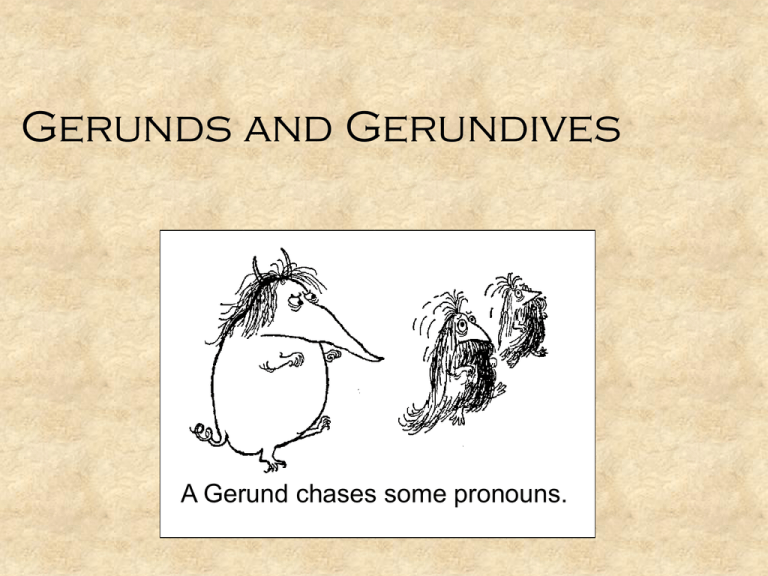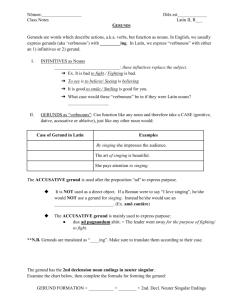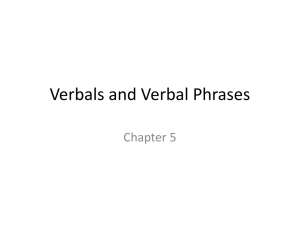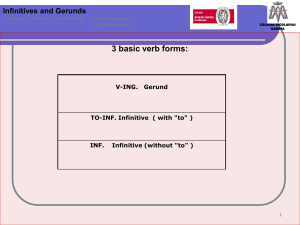Chapter XII: The Reflexive Pronoun & Adjective
advertisement

Gerunds and Gerundives A Gerund chases some pronouns. Verbal Nouns in Latin • In Latin, there are two types of verbal nouns. – – • Infinitives (“to verb”) Gerunds (“verbing”) We have already learned to form the infinitive, which has its own box in a verbal synopsis. Today, we will add the other verbal noun, the gerund. Gerunds • • • • A gerund is a verbal noun that is typically translated as “verbing”. Although it ends in “-ing”, it is not a participle because it does not modify another noun. Watch out for the running man! Man, I really love running! Gerunds • • Forming gerunds is a process almost identical to forming the gerundive. Remember, a gerundive was the future passive participle that we learned a few weeks ago and ended in ndus, nda, ndum. Active Passive Present amans, ntis ___________________ Past (Perfect) ___________________ amatus, a, um Future amaturus, ura, urum amandus, a, um The Gerundive • To form the Gerundive, simply take the Present Stem from a verb and add “ndus, a, um” onto it. – • • cf. Amanda, Miranda and agenda Again, as with the Present Active Participle, verbs of the 3rd-io and 4th conjugations add an ‘i’ to the stem before the “ndus, a, um” A good way to remember the ending is from the word gerundive. Gerunds Steps to forming a Gerund 1. Find the present active infinitive (the 2nd principle part). amō, amāre, amāvī, amātum • 2. Take off the -re. 1. 3. Add nd to the stem [remember -ie- for 3rd io and 4 C] 1. 4. amā ama + -nd Add the 2nd declension neuter endings…. Gerunds The Gerund of amō, amāre, amāvī, amātum Nom. amāre to love Gen. amāndī of loving Dat. amāndō to/for loving Acc. amāndum loving Abl. amāndō by loving Gerunds • Things to note about the formation of Gerunds: 1. There is no nominative gerund. The form is fulfilled by the present active infinitive. 2. These are the only forms of gerunds. They do not have different masculine, feminine or neuter forms; they have no plurals too. Nom. amāre to love Gen. amāndī of loving Dat. amāndō to/for loving Acc. amāndum loving Abl. amāndō by loving Practice 1. genitive, singular, gerund of videō, vidēre 2. accusative, singular, gerund of rogō, rogāre 3. ducendō dative, singular, gerund of capiō, capere 5. rogāndum ablative, singular, gerund of ducō, ducere 4. vidēndī capiendō nominative, singular, gerund of audiō, audīre audīre Using Gerunds • • A gerund is used in the same fashion as a normal noun. Therefore, it can have any nominal syntax (objective genitive, ablative of means, etc.) Mihi est amor scrībendī. There is for me a love of writing. Using Gerunds for Purpose • • • • Two other constructions use gerunds to express purpose as well. The words causā and grātiā take the gerund in the genitive to express purpose. In this construction, the gerund is always placed before causā and grātiā. causā and grātiā are both translated as “for the sake of” Rōmam vēnī multa videndī causā. I came to Rome for the sake of seeing many things. Using Gerunds for Purpose • • • In addition, ad can be used with a gerund in the accusative to express purpose. In this construction, the gerund is usually placed after ad. ad is translated as “for the purpose of” Arma cēpit ad pugnandum. He took up arms for the purpose of fighting. Practice 1. Quamquam mē ducis, magnus est timor errandī. 2. In prōvinciā manendō, Caesar incolās terrēbat. 3. A wise one wins many friends by giving. Multa videndī grātiā per viās ībant. 5. By staying in the province, Caesar used to frighten the inhabitants. Sapiens multōs amīcōs dandō capit. 4. Although you lead me, great is the fear of erring. They used to go through the streets for the sake of seeing many things. Fās est īre in templum? Is it allowed to go into the temple? Gerundives • • • We have already seen gerundives and have learned that they should be translated as “ought to be verbed”. In addition, they too can be used with causā, grātiā, and ad to express purpose. However, the difference between this usage and the use of a gerund is that the gerundive modifies something and the gerund stands alone. In Exempla Rōmam vēnī multa videndī causā. I came to Rome for the sake of seeing many things. Rōmam vēnī multa matrem videndam causā. I cam to Rome for the sake of seeing (my) mother. Arma cēpit ad pugnandum. He took up arms for the purpose of fighting. Arma cēpit ad pugnandum hostem. He took up arms for the purpose of fighting the enemy. Practice 1. Lēgātōs pācis petendae causā sociī mīsērunt. 2. The allies sent envoys for the sake of seeking peace. Rōmānīs erat studium bellōrum gerendōrum. There was a desire for the Romans of waging wars. Gerunds vs. Gerundives • Therefore, the basic difference between gerunds and gerundives is that . . . . GERUNDIVES MODIFY SOMETHING BUT GERUNDS STAND ALONE. Homework? • Homework 46 (Due Monday!)











